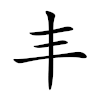丰
| ||||||||
Translingual
| Stroke order | |||
|---|---|---|---|
 | |||
Exists as traditional character, but also Simplified from 豐 (elimination of 豈 and 丰).
| Traditional | 豐 |
|---|---|
| Shinjitai | 豊 |
| Simplified | 丰 |
Han character
丰 (Kangxi radical 2, 丨+3, 4 strokes, cangjie input 手十 (QJ), four-corner 50000, composition ⿻三丨(GJKV) or ⿻⿱㇒二丨(HT))
References
- Kangxi Dictionary: page 79, character 8
- Dai Kanwa Jiten: character 76
- Dae Jaweon: page 161, character 3
- Hanyu Da Zidian (first edition): volume 1, page 28, character 7
- Unihan data for U+4E30
Chinese
Glyph origin
| Historical forms of the character 丰 | |||||||
|---|---|---|---|---|---|---|---|
| Shang | Western Zhou | Shuowen Jiezi (compiled in Han) | Liushutong (compiled in Ming) | ||||
| Oracle bone script | Bronze inscriptions | Small seal script | Transcribed ancient scripts | ||||
 |
 |
 |
 | ||||
| |||||||
|
References: Mostly from Richard Sears' Chinese Etymology site (authorisation),
| |||||||
Characters in the same phonetic series (丰) (Zhengzhang, 2003)
| Old Chinese | |
|---|---|
| 邦 | *proːŋ |
| 梆 | *proːŋ |
| 垹 | *proːŋ |
| 肨 | *pʰroːŋs, *pʰroːŋs |
| 蚌 | *broːŋʔ, *breːŋʔ |
| 玤 | *broːŋʔ |
| 棒 | *broːŋʔ |
| 蜯 | *broːŋʔ |
| 琫 | *poːŋʔ |
| 菶 | *poːŋʔ, *boːŋʔ |
| 俸 | *poːŋʔ, *boŋs |
| 髼 | *boːŋ |
| 蜂 | *boːŋ, *pʰoŋ |
| 韸 | *boːŋ |
| 蓬 | *boːŋ |
| 篷 | *boːŋ |
| 唪 | *boːŋʔ, *boŋʔ |
| 埲 | *boːŋʔ |
| 丰 | *pʰoŋ |
| 妦 | *pʰoŋ |
| 仹 | *pʰoŋ |
| 峯 | *pʰoŋ |
| 峰 | *pʰoŋ |
| 鋒 | *pʰoŋ |
| 烽 | *pʰoŋ |
| 蠭 | *pʰoŋ |
| 桻 | *pʰoŋ |
| 莑 | *pʰoŋ |
| 夆 | *pʰoŋ, *boŋ, *ɡaːds |
| 捧 | *pʰoŋʔ |
| 逢 | *boŋ |
| 縫 | *boŋ, *boŋs |
| 漨 | *boŋ |
| 捀 | *boŋ, *boŋs |
| 奉 | *boŋʔ |
Pictogram (象形) . The original version is 𡴀.
Etymology 1
| For pronunciation and definitions of 丰 – see 豐 (“luxuriant; lush; abundant; bountiful; plenty; etc.”). (This character is the simplified form of 豐). |
Notes:
|
Pronunciation
Compounds
Korean
Hanja
丰 (eumhun 예쁠 봉 (yeppeul bong))
- This term needs a translation to English. Please help out and add a translation, then remove the text
{{rfdef}}.
References
Vietnamese
This article is issued from Wiktionary. The text is licensed under Creative Commons - Attribution - Sharealike. Additional terms may apply for the media files.



